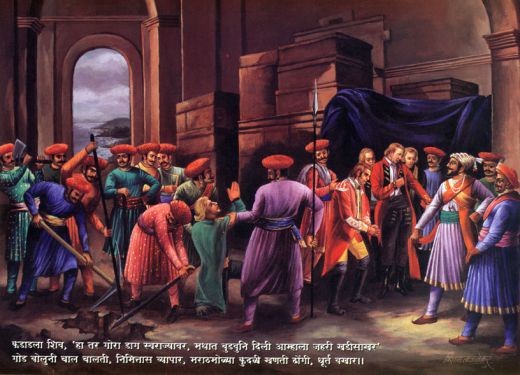Art and Culture: Shivaji was a patron of art and culture, piety and letters. Prominent among the saintly persons whom Shivaji admired were Ramdas, Tukaram, Baba Yakub, Mauni Baba, etc. Sanskrit poets like Jairam, Paramananda, Gaga Bhatt, and some Hindi poets received his patronage.
Administrative system of Shivaji: The administrative system of Shivaji was largely borrowed from the administrative practices of the Deccan states. It was also influenced by the principles laid down in Kautilya’s Arthasastra and the Dharmasastras. In the discharge of his duties he was assisted by a council of ministers.
Provincial administration: Shivaji divided the territory under his direct rule (which he called the Swaraj territory) into a number of provinces. The ancient institution of the Panchyat was preserved in the rural areas. The head of the village, administered the village with the help of the panchyat.
Revenue system: Shivaji laid down an excellent revenue system based on the principles adopted by Todar Mal and Malik Ambar. His officers made an elaborate survey of the land and fixed the rent at 33 per cent of the gross produce. Shivaji afterwards demanded a consolidated rent of 40 per cent. It is however, wrong to assume that Shivaji abolished the jagirdari system.
Chauth and Sardeshmukhi: Chauth and Sardeshmukhi were also the main sources of income of the state. They were levied on the territories which were not under the direct control of Shivaji. The inhabitants of these areas paid the Chauth or one fourth of the standard revenue as protection money against the plundering raids of Shivaji. The territories and principalities which paid chauth were also required to pay an additional tax called Sardeshmukhi. This was one tenth of the revenue of those areas. Those who paid Sardeshmukhi received Marathi protection against other invaders. Both the taxes together made a sizeable income for the Maratha kings.
Military system: Shivaji created and maintained an organized and disciplined army consisting of infantry, cavalry and navy. Shivaji recruited only able persons in his army. He had the skills to manage a huge army. His army mostly composed of light infantry and light cavalry was admirably well-adapted to guerilla warfare and hill campaign. The army movements were extremely quick.
Forts played an important role in Shivaji’s military system. Every fort was kept under three officers of equal status. They acted together but served as a check on one another.
Shivaji recognized the necessity of a strong navy. He had a navy of about 200 warships. The creation of a navy shows the foresight of Shivaji. A number of coastal fortresses kept guard over the sea. The Portuguese, the British, the Siddis and the Mughals were thus effectively kept in check.
Nor were Shivaji’s intelligence service neglected. The espionage system formed a well-paid and efficient wing of the Maratha army.
Death of Shivaji: Chhatrapati Shivaji Maharaj died on April 3, 1680. After the death of Shivaji, his sonSambhaji Maharaj(1680-1689) succeeded him. After the death of Sambhaji , his brother, Rajaram Maharaj, assumed the leadership of Maratha Empire and continued the struggle.



